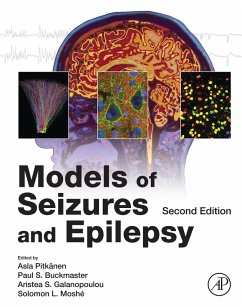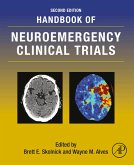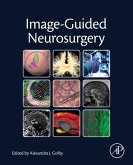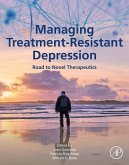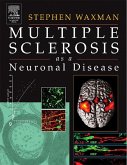Models of Seizures and Epilepsy (eBook, ePUB)
Redaktion: Pitkänen, Asla; Moshé, Solomon L.; Galanopoulou, Aristea S; Paul Buckmaster, Dvm


Alle Infos zum eBook verschenken

Models of Seizures and Epilepsy (eBook, ePUB)
Redaktion: Pitkänen, Asla; Moshé, Solomon L.; Galanopoulou, Aristea S; Paul Buckmaster, Dvm
- Format: ePub
- Merkliste
- Auf die Merkliste
- Bewerten Bewerten
- Teilen
- Produkt teilen
- Produkterinnerung
- Produkterinnerung

Hier können Sie sich einloggen

Bitte loggen Sie sich zunächst in Ihr Kundenkonto ein oder registrieren Sie sich bei bücher.de, um das eBook-Abo tolino select nutzen zu können.
Models of Seizures and Epilepsy, Second Edition, is a valuable, practical reference for investigators who are searching for the most appropriate laboratory models to address key questions in the field. The book also provides an important background for physicians, fellows, and students, offering insight into the potential for advances in epilepsy research as well as R&D drug development. Contents include the current spectrum of models available to model different epilepsy syndromes, epilepsy in transgenic animals, comorbidities in models of epilepsy, and novel technologies to study seizures…mehr
- Geräte: eReader
- mit Kopierschutz
- eBook Hilfe
- Größe: 57.43MB
![Models of Seizures and Epilepsy (eBook, ePUB) Models of Seizures and Epilepsy (eBook, ePUB)]() Models of Seizures and Epilepsy (eBook, ePUB)132,95 €
Models of Seizures and Epilepsy (eBook, ePUB)132,95 €![Handbook of Neuroemergency Clinical Trials (eBook, ePUB) Handbook of Neuroemergency Clinical Trials (eBook, ePUB)]() Handbook of Neuroemergency Clinical Trials (eBook, ePUB)125,95 €
Handbook of Neuroemergency Clinical Trials (eBook, ePUB)125,95 €![Image-Guided Neurosurgery (eBook, ePUB) Image-Guided Neurosurgery (eBook, ePUB)]() Image-Guided Neurosurgery (eBook, ePUB)105,95 €
Image-Guided Neurosurgery (eBook, ePUB)105,95 €![Neurosurgical Neuropsychology (eBook, ePUB) Neurosurgical Neuropsychology (eBook, ePUB)]() Neurosurgical Neuropsychology (eBook, ePUB)86,95 €
Neurosurgical Neuropsychology (eBook, ePUB)86,95 €![Managing Treatment-Resistant Depression (eBook, ePUB) Managing Treatment-Resistant Depression (eBook, ePUB)]() Managing Treatment-Resistant Depression (eBook, ePUB)161,95 €
Managing Treatment-Resistant Depression (eBook, ePUB)161,95 €![Handbook of Brain Tumor Chemotherapy, Molecular Therapeutics, and Immunotherapy (eBook, ePUB) Handbook of Brain Tumor Chemotherapy, Molecular Therapeutics, and Immunotherapy (eBook, ePUB)]() Handbook of Brain Tumor Chemotherapy, Molecular Therapeutics, and Immunotherapy (eBook, ePUB)169,95 €
Handbook of Brain Tumor Chemotherapy, Molecular Therapeutics, and Immunotherapy (eBook, ePUB)169,95 €![Multiple Sclerosis As A Neuronal Disease (eBook, ePUB) Multiple Sclerosis As A Neuronal Disease (eBook, ePUB)]() Stephen WaxmanMultiple Sclerosis As A Neuronal Disease (eBook, ePUB)143,95 €
Stephen WaxmanMultiple Sclerosis As A Neuronal Disease (eBook, ePUB)143,95 €-
-
-
- Provides a comprehensive reference detailing animal models of epilepsy and seizure
- Offers insights on the use of novel technologies that can be applied in experimental epilepsy research
- Edited by leading experts in the field that provide not only technical reviews of these models but also conceptual critiques
- Comments on the strengths and limitations of various models, including their relationship to clinical phenomenology and their value in developing better understanding and treatments
Dieser Download kann aus rechtlichen Gründen nur mit Rechnungsadresse in A, B, BG, CY, CZ, D, DK, EW, E, FIN, F, GR, HR, H, IRL, I, LT, L, LR, M, NL, PL, P, R, S, SLO, SK ausgeliefert werden.
- Produktdetails
- Verlag: Elsevier Science & Techn.
- Seitenzahl: 1178
- Erscheinungstermin: 14. Juni 2017
- Englisch
- ISBN-13: 9780128040676
- Artikelnr.: 48497221
- Verlag: Elsevier Science & Techn.
- Seitenzahl: 1178
- Erscheinungstermin: 14. Juni 2017
- Englisch
- ISBN-13: 9780128040676
- Artikelnr.: 48497221
Dr. Buckmaster is an Associate Professor of Comparative Medicine and Neurology at Stanford University School of Medicine in Stanford, California. His laboratory uses electrophysiological and anatomical techniques to evaluate neuronal circuitry of temporal lobe structures in normal and epileptic brains. He is a veterinarian with 25 years of experience investigating mechanisms of temporal lobe epilepsy using anatomical and electrophysiological techniques. He has worked with a variety of mammalian species, including primates, carnivores, and rodents. He has an h-index of 29 and has published over 74 articles.
Dr. Galanopoulou is an Attending Physician at the Clinical Neuroscience Center and EEG lab at Montefiore, a Professor of Neurology and Neuroscience at Albert Einstein College of Medicine in Bronx, New York. She is also the co-chair of the AES/ILAE Translational Research Task Force of the ILAE, which works towards the optimization of the use of animal models of seizures, epilepsies, and comorbidities in epilepsy research. She is a clinical epileptologist with 15 years' experience with epilepsy basic research using a variety of animal models and particularly models of early life seizures and epilepsies. She has an h-index of 29 and has published over 84 articles.
Technical and methodological issues 8. Monitoring for Seizures in Rodents 9. Behavioral characterization and scoring of seizures in rodents 10. Seizure mimics 11. Characterization of pathology 12. Monitoring cardiorespiratory and other physiological parameters during seizures in small animals 13. Behavioral and cognitive testing procedures in animal models of epilepsy 14. In vivo Imaging in rodents
In vitro and in silico models 15. Hippocampal in silico models of seizures and epilepsy 16. Neocortical/thalamic in silico models of seizures and epilepsy 17. iPS cells, stem cells 18. Hippocampus in vitro 19. Thalamus and cortex in vitro 20. Brain slices from human resected tissues 21. Organotypic Hippocampal Slice cultures as a Model of Post-traumatic Epileptogenesis 22. The in vitro isolated guinea pig brain in the study of ictogenesis
Non-mammalian in vivo models 23. Nematode C. elegans: Genetic Dissection of Pathways Regulating Seizure and Epileptic-like Behaviors 24. Drosophila 25. Xenopus laevis 26. Zebrafish models of epilepsy and epileptic seizures
Naturally occurring seizures and epilepsies in animals 27. Veterinarian's perspective 28. Naturally occurring epilepsy and status epilepticus in dogs 29. Naturally Occurring Temporal Lobe Epilepsy in Cats 30. Naturally occurring epilepsy and status epilepticus in Sea lions 31. Baboon Model of Genetic Generalized Epilepsy 32. Genetic Models of Reflex Epilepsy and SUDEP in Rats and Mice 33. Genetic models of absence epilepsy in rats and mice
In vivo mammalian models of induced seizures and status epilepticus 34. Electrical stimulation 35. Systemic Chemoconvulsants Producing Acute Seizures in Adult Rodents 36. Focally applied chemoconvulsants 37. Models of Chemically-Induced Acute seizures and Epilepsy: Toxic compounds and drugs of addiction 38. Pharmacologically induced animal models of absence seizures 39. Models of seizures and status epilepticus early in life
In vivo mammalian models of acquired epilepsies 40. Tetanus toxin 41. Post-SE models: Systemic kainic acid 42. Post-SE models: Focal kainic acid 43. The Pilocarpine Model of Acquired Epilepsy 44. Post-Status Epilepticus models: Electrical stimulation 45. Post-SE models: Hyperthermia 46. Epilepsy after TBI 47. Post-infectious epilepsy 48. Post-perinatal hypoxia 49. Perinatal Hypoxic-Ischemic Encephalopathy: A Model of Stroke-Induced Pediatric Epilepsy 50. Post-stroke epilepsy 51. Animal Models of Drug-Refractory Epilepsy
In vivo mammalian models of genetic epilepsies with identified gene 52. Spontaneous and Gene-Directed Epilepsy Mutations in the Mouse 53. Dravet and GEFS+ syndromes 54. Tuberous sclerosis and other toropathies
Modeling conditions that predispose to seizures or epilepsy 55. Kindling (including fast and slow kindlers) 56. Human mutations associated with brain malformations resulting in hyperexcitability in rodents 57. Dysplasias - Cortical freeze lesion 58. Dysplasia - MAM, model of developmental epilepsy 59. Dysplasias - In utero irradiation 60. Undercut cortex 61. Brain tumor-related epilepsy 62. Withdrawal seizures 63. Perimenstrual seizures and neurosteroid withdrawal 64. Metabolic disturbances: Hypo- and hyperglycemic seizures in vivo and in vitro 65. Stress 66. Blood Brain Barrier disruption 67. Experimental models of inflammation in epilepsy research
Other specific epilepsy-related syndromes 68. Infantile spasms 69. Models of epileptic encephalopathies 70. Sudep Animal Models
Animal models of other brain diseases with altered seizure susceptibility 71. Epilepsy in Models of Alzheimer's disease 72. Animal Models of Acquired Epilepsy and Tauopathies 73. Epilepsy in other neurodegenerative disorders: Huntington's and Parkinson's diseases 74. Animal models of other brain diseases with altered seizure susceptibility: Autism and Fragile X Syndrome 75. Epilepsy in Models of Rett syndrome 76. Models of depression
Conclusions 77. What do models model? What needs to be modeled?
Technical and methodological issues 8. Monitoring for Seizures in Rodents 9. Behavioral characterization and scoring of seizures in rodents 10. Seizure mimics 11. Characterization of pathology 12. Monitoring cardiorespiratory and other physiological parameters during seizures in small animals 13. Behavioral and cognitive testing procedures in animal models of epilepsy 14. In vivo Imaging in rodents
In vitro and in silico models 15. Hippocampal in silico models of seizures and epilepsy 16. Neocortical/thalamic in silico models of seizures and epilepsy 17. iPS cells, stem cells 18. Hippocampus in vitro 19. Thalamus and cortex in vitro 20. Brain slices from human resected tissues 21. Organotypic Hippocampal Slice cultures as a Model of Post-traumatic Epileptogenesis 22. The in vitro isolated guinea pig brain in the study of ictogenesis
Non-mammalian in vivo models 23. Nematode C. elegans: Genetic Dissection of Pathways Regulating Seizure and Epileptic-like Behaviors 24. Drosophila 25. Xenopus laevis 26. Zebrafish models of epilepsy and epileptic seizures
Naturally occurring seizures and epilepsies in animals 27. Veterinarian's perspective 28. Naturally occurring epilepsy and status epilepticus in dogs 29. Naturally Occurring Temporal Lobe Epilepsy in Cats 30. Naturally occurring epilepsy and status epilepticus in Sea lions 31. Baboon Model of Genetic Generalized Epilepsy 32. Genetic Models of Reflex Epilepsy and SUDEP in Rats and Mice 33. Genetic models of absence epilepsy in rats and mice
In vivo mammalian models of induced seizures and status epilepticus 34. Electrical stimulation 35. Systemic Chemoconvulsants Producing Acute Seizures in Adult Rodents 36. Focally applied chemoconvulsants 37. Models of Chemically-Induced Acute seizures and Epilepsy: Toxic compounds and drugs of addiction 38. Pharmacologically induced animal models of absence seizures 39. Models of seizures and status epilepticus early in life
In vivo mammalian models of acquired epilepsies 40. Tetanus toxin 41. Post-SE models: Systemic kainic acid 42. Post-SE models: Focal kainic acid 43. The Pilocarpine Model of Acquired Epilepsy 44. Post-Status Epilepticus models: Electrical stimulation 45. Post-SE models: Hyperthermia 46. Epilepsy after TBI 47. Post-infectious epilepsy 48. Post-perinatal hypoxia 49. Perinatal Hypoxic-Ischemic Encephalopathy: A Model of Stroke-Induced Pediatric Epilepsy 50. Post-stroke epilepsy 51. Animal Models of Drug-Refractory Epilepsy
In vivo mammalian models of genetic epilepsies with identified gene 52. Spontaneous and Gene-Directed Epilepsy Mutations in the Mouse 53. Dravet and GEFS+ syndromes 54. Tuberous sclerosis and other toropathies
Modeling conditions that predispose to seizures or epilepsy 55. Kindling (including fast and slow kindlers) 56. Human mutations associated with brain malformations resulting in hyperexcitability in rodents 57. Dysplasias - Cortical freeze lesion 58. Dysplasia - MAM, model of developmental epilepsy 59. Dysplasias - In utero irradiation 60. Undercut cortex 61. Brain tumor-related epilepsy 62. Withdrawal seizures 63. Perimenstrual seizures and neurosteroid withdrawal 64. Metabolic disturbances: Hypo- and hyperglycemic seizures in vivo and in vitro 65. Stress 66. Blood Brain Barrier disruption 67. Experimental models of inflammation in epilepsy research
Other specific epilepsy-related syndromes 68. Infantile spasms 69. Models of epileptic encephalopathies 70. Sudep Animal Models
Animal models of other brain diseases with altered seizure susceptibility 71. Epilepsy in Models of Alzheimer's disease 72. Animal Models of Acquired Epilepsy and Tauopathies 73. Epilepsy in other neurodegenerative disorders: Huntington's and Parkinson's diseases 74. Animal models of other brain diseases with altered seizure susceptibility: Autism and Fragile X Syndrome 75. Epilepsy in Models of Rett syndrome 76. Models of depression
Conclusions 77. What do models model? What needs to be modeled?
